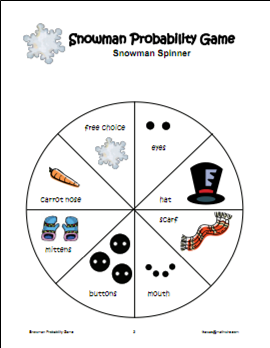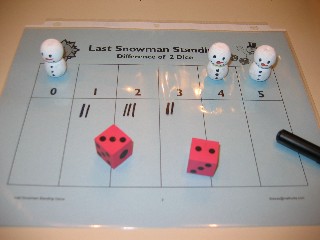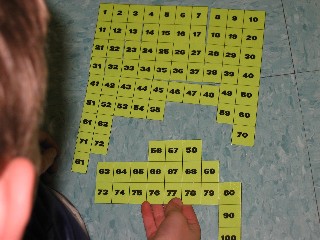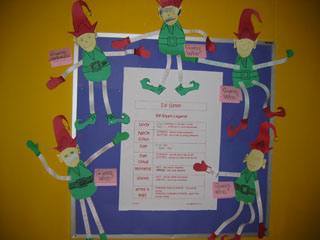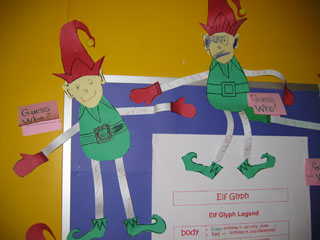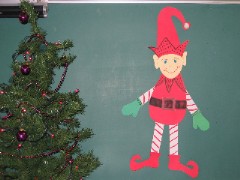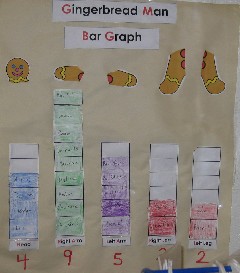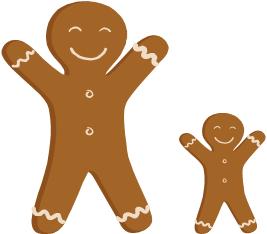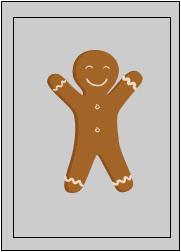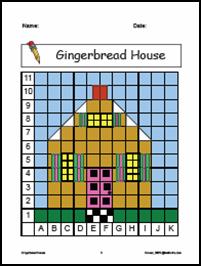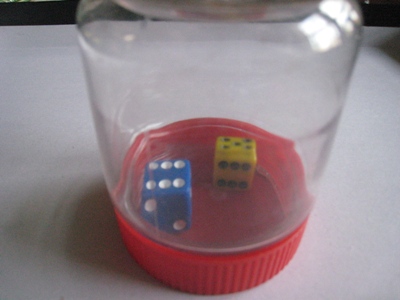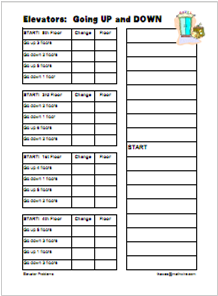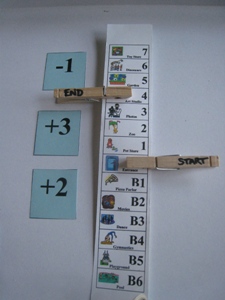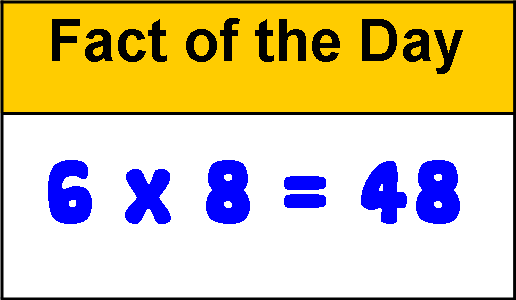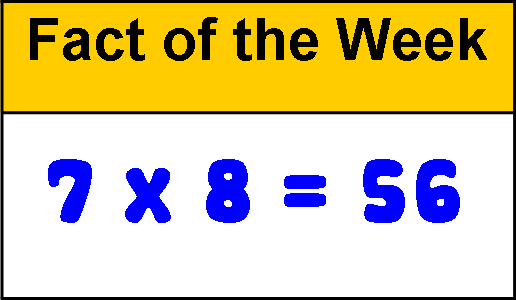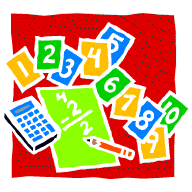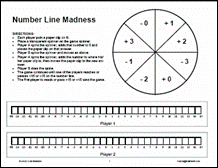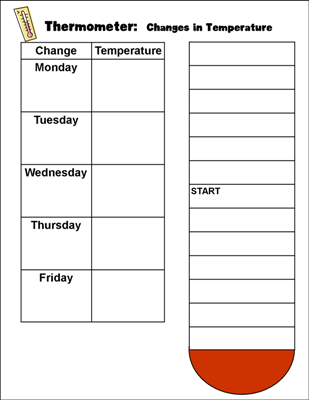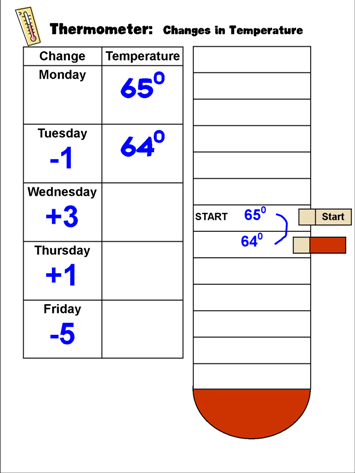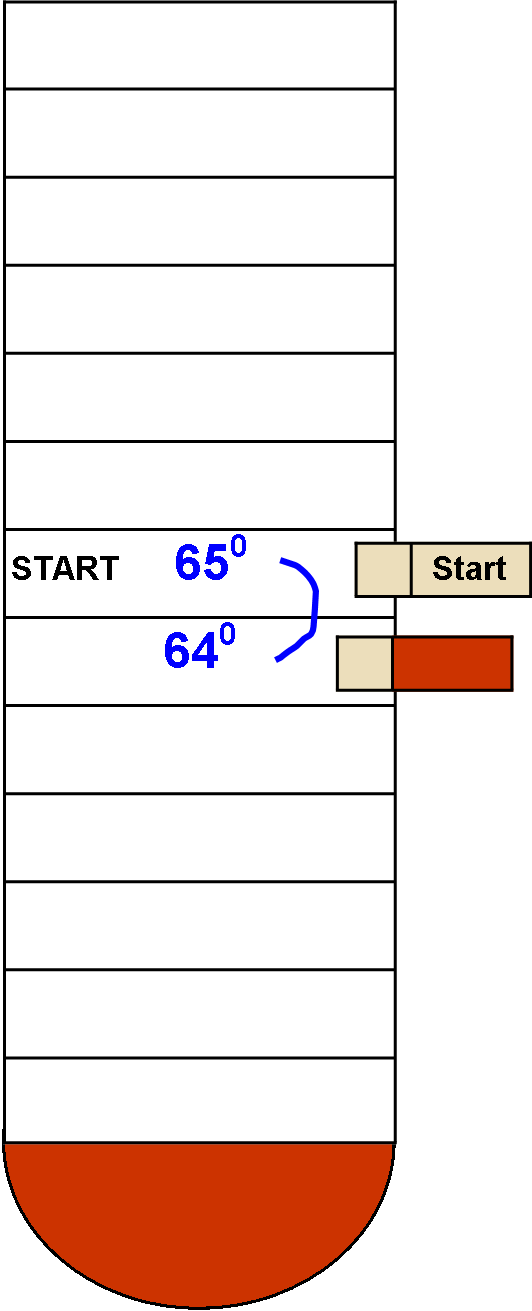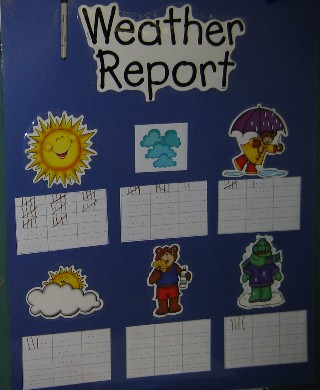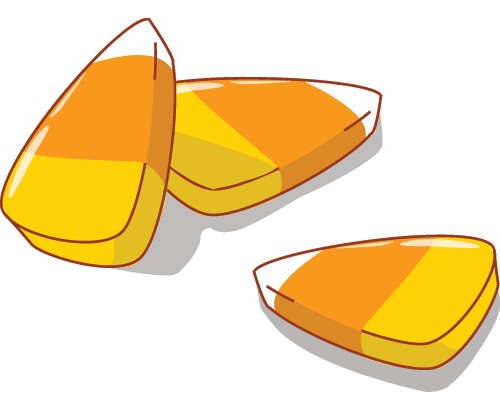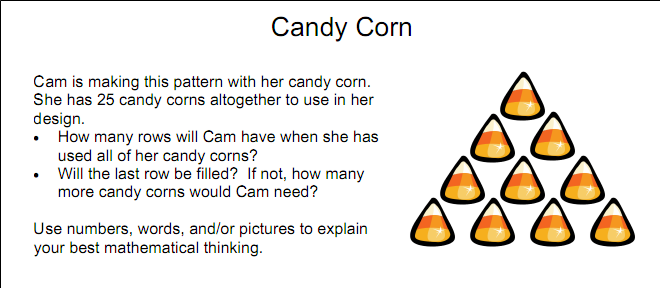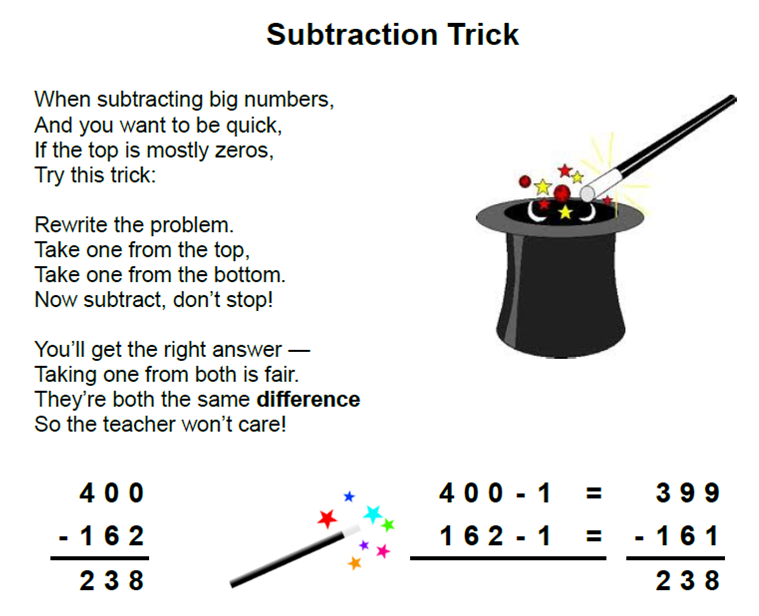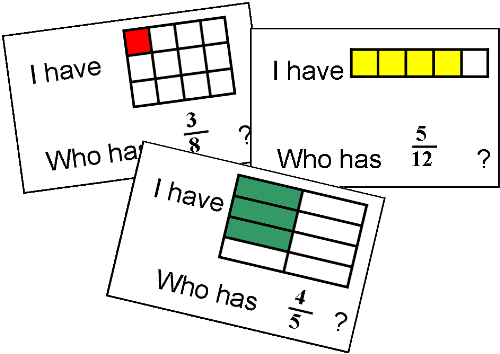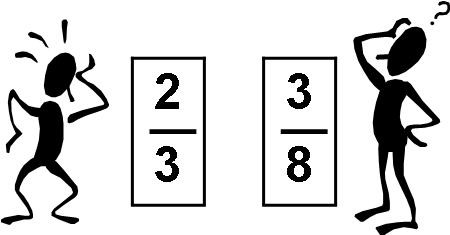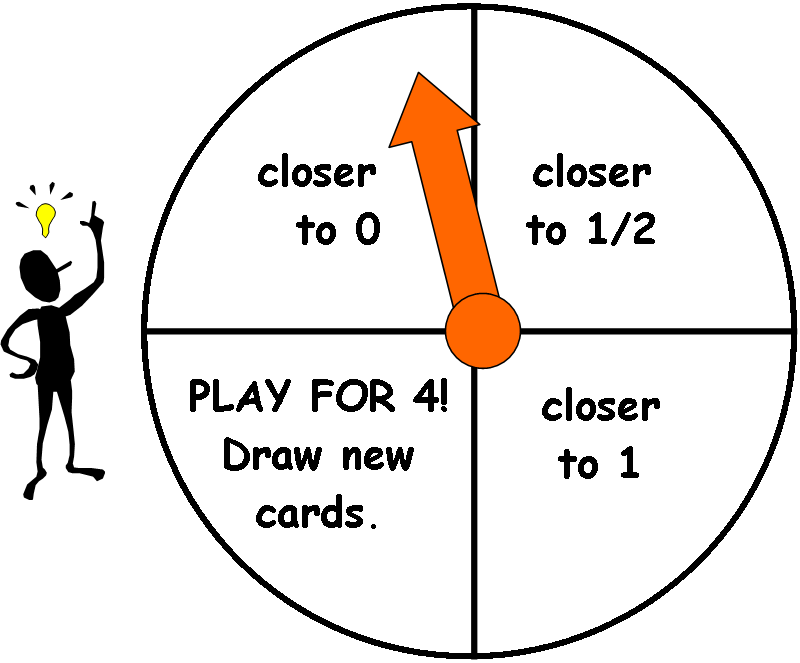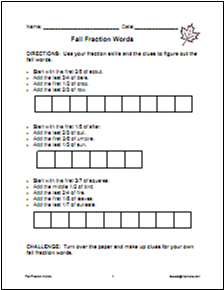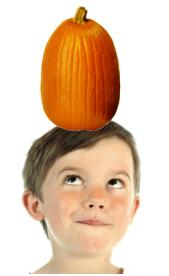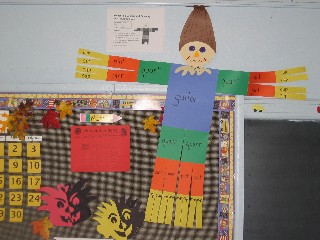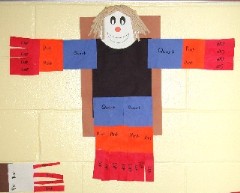This activity is designed as a fun, seasonal data collection activity that introduces students to the probability of a spinner. Although each piece of the snowman is equally likely to be spun, the actual game results are often quite different.
In this game, students spin to win all of the pieces to create the snowman. Students may place a transparent spinner over the spinner template, or use a pencil and paper clip to create a spinner.
Before playing, ask students to estimate how many spins they think they will need to collect all of the pieces for their snowman. Call on students to share both their number of spins and why they think that is a reasonable number. Record these estimates for later discussion.
Give each student a copy of the game mat and insert the mat into a clear sheet protector. Students may then use dry erase pens to draw the pieces as they collect them.
Have students use the Snowman Probability Recording Sheet to collect data on how many spins it takes to get all of the pieces. Insert this sheet in a clear sheet protector for a renewable activity. Be sure to collate the class data and analyze this larger sample to get an approximate number of spins required.
Download the Snowman Probability Game file which includes the game mat, spinner, directions and recording sheet.

Friday, December 16, 2011
Thursday, December 15, 2011
Last Snowman Standing Game
The snowmen face off in this game of addition facts. But beware! A toss of the die may mean the sun melts a snowman. Students practice addition facts as they try to be the last snowman standing because in this game the first person to remove all of his/her snowmen loses the game!
Download the  Last Snowman Standing Game for directions and game mats for three different versions of the game:
Last Snowman Standing Game for directions and game mats for three different versions of the game:
 Last Snowman Standing Game for directions and game mats for three different versions of the game:
Last Snowman Standing Game for directions and game mats for three different versions of the game:- Sum of Two Dice Version to practice addition facts
- Difference of Two Dice Version to practice subtraction facts
- One Die Toss for a simplified version to analyze the probability of a die toss
Data Collection: The directions for each version also include directions for data collection and analysis of the outcomes of the games. Be sure to incorporate these activities, if at all possible, as games offer a highly motivational study in probability. Students love to "play games" to collect data. They're also eager to analyze games so that they learn how the game works and what strategies they can use to improve their odds of winning.
Differentiation: This game offers many opportunities to differentiate the activity. First of all, teachers are able to select from three different versions. Secondly, each teacher should differentiate the game analysis to meet the instructional level of his/her students. Most students can handle the questions with teacher guidance. Older students and talented primary students may be challenged to analyze the game and answer the questions in small groups.
Read about the Last Snowman Standing game on Mathwire.
Read about the Last Snowman Standing game on Mathwire.
Tuesday, December 13, 2011
Hundred Board Puzzles
Students learn the patterns in the hundred board by assembling puzzles. Teachers are able to assess student use of patterns in rows and columns by observing the student at work.
This task is easily differentiated to accommodate the varied levels in a first grade class by changing the number of pieces and the shape of the pieces. Puzzle bags should be sequentially lettered so that students progress through harder versions of the task.
Finally, students are asked to create their own puzzles for classmates to solve.
Download a hundred board template to copy onto card stock and then cut apart to create puzzles.
This task is easily differentiated to accommodate the varied levels in a first grade class by changing the number of pieces and the shape of the pieces. Puzzle bags should be sequentially lettered so that students progress through harder versions of the task.
Finally, students are asked to create their own puzzles for classmates to solve.
Download a hundred board template to copy onto card stock and then cut apart to create puzzles.
Monday, December 12, 2011
Elf Glyph
This Mathwire elf glyph comes complete with legend and downloadable patterns to create your student glyphs. As with all glyphs, teachers should feel free to adjust the legend to best fit the information on your students.
Creating their own glyphs requires students to follow a legend. However, teachers should be sure to also provide opportunities for students to analyze the class glyphs with questions that require them to identify specific information in the glyphs such as:
- Does anyone have a "twin glyph" or someone whose glyph is exactly like yours?
- How many people in the class like to make snowmen?
- Do more people like warm weather or cold weather?
- How many girls like to go sledding?
Friday, December 9, 2011
Gingerbread Graph Ideas
It is very easy to incorporate graphing into a gingerbread man unit. Consider these possibilities to get the creative juices flowing. Remember to include different kinds of graphs as suggested below.
- Gingerbread Info.: As an introduction to the unit, graph how many students have eaten a gingerbread cookie, baked a gingerbread cookie or decorated a gingerbread cookie. [clothespin graph with simple yes/no options]
- Gingerbread Bites: Ask students to take one bite of their gingerbread cookie. Graph or tally how many students bit off the head, the right arm, left arm, right leg or left leg. [bar graph, as shown, or pictograph using pieces]
- Gingerbread Taste Test: Have children taste several different gingerbread cookies, including homemade and store-bought. Ask students to vote for their favorite cookie. [bar graph]
- Gingerbread Man Stories: After reading several different versions of the classic story, ask students to vote on their favorite. [pictograph using book die cuts]
- Gingerbread Unit: At the conclusion of the gingerbread unit, have students vote on their favorite activity. [bar graph]
Thursday, December 8, 2011
Catch the Gingerbread Man Game
For this game, students toss two dice (one regular and one marked A-B-C-D-E-F), form an ordered pair (e.g. B5), then remove the gingerbread man from that space, if there is one. Play continues until the timer rings or until one player has caught 10 gingerbread men. Students love playing the game and they get to practice their coordinate graphing skills in the process.
Coordinate Pairs: This seasonal version of the classic Battleship game provides practice in forming coordinate pairs, identifying the x-coordinate (A-F), then the y-coordinate (1-6) so that spaces are identified as C3 or E6. Hopefully, lots of practice will help students transition to the algebraic ordered pairs (x,y) where x and y are both numbers. Just be certain to reinforce the notion that the x-coordinate (across) comes before the y-coordinate (up or down). The alphabetical cues (across comes before up or down) help some students remember the order.
Download Catch the Gingerbread Man Game which includes game mat, directions and game pieces.
Tuesday, December 6, 2011
Gingerbread Man Problem Solving
Students are asked to use words, pictures and numbers to solve these gingerbread problems:
Gingerbread Bake Sale challenges students to figure out how many different gingerbread men Ruby can make for the holiday bake sale.
Gingerbread Man Chains requires students to calculate how many gingerbread men will be needed to create chains across the bulletin board. Students also need to figure out how many sheets of brown construction paper will be needed for the project.
Creative Extension: Ask students to write original problems that involve the gingerbread man. Encourage them to think of measurement and patterns as well as numbers and operations as they create their word problems. Provide time for students to type in, print out and decorate their problems. Assemble them into a class Gingerbread Man booklet that may be shared with other classes as well.
Gingerbread Bake Sale challenges students to figure out how many different gingerbread men Ruby can make for the holiday bake sale.
Gingerbread Man Chains requires students to calculate how many gingerbread men will be needed to create chains across the bulletin board. Students also need to figure out how many sheets of brown construction paper will be needed for the project.
Creative Extension: Ask students to write original problems that involve the gingerbread man. Encourage them to think of measurement and patterns as well as numbers and operations as they create their word problems. Provide time for students to type in, print out and decorate their problems. Assemble them into a class Gingerbread Man booklet that may be shared with other classes as well.
Gingerbread Man Math
Gingerbread men and gingerbread houses enjoy special popularity around the holidays, but many of these gingerbread activities are timeless and complement literature titles that teachers use at the beginning of school or after the holidays. It's very easy to incorporate mathematics into a study of gingerbread men, and students will enjoy the data collection activities and games while learning math skills and deepening their understanding of important mathematical concepts.
Look through these math activities and add some to your repertoire. Consider broadening the gingerbread math to include measurement, games and problem solving this year.
Check out Mathwire's Gingerbread Man Math collection, part of Mathwire's themed math activities collection.
Monday, December 5, 2011
Gingerbread House Math
Introduce elementary students to coordinate graphing through seasonal coloring activities. This winter Gingerbread House activity requires students to use the grid code and crayons or markers to create a gingerbread house on a blank 11x11 grid. The use of letters on the horizontal axis and numbers on the vertical axis introduces young students to coordinate pairs without the confusion of the standard (h,v) format. Notice that it is important that elementary students become accustomed to listing the horizontal coordinate first as this will transfer to the Cartesian coordinates they will use in later grades.
See more Mathwire Gingerbread House activities.
See more Mathwire Gingerbread House activities.
Friday, December 2, 2011
Counting Game: Run, Gingerbread Men, Run!
This game was designed to introduce students to the randomness of spinners and dice. Each color gingerbread man starts at the same place and has the same chance of winning by crossing the finish line, but does it work out that way? Students will enjoy playing the game AND use a clothespin graph [see sample on right] to collect some useful data on the winners.
Once students have collected class data from playing many games, they will come together to analyze the clothespin graph results. Students will be asked to discuss whether or not they think the game is fair for all of the gingerbread men and explain their reasoning.
Download the Run, Gingerbread Men, Run! game so that students can get started playing and collecting data. The pdf file contains the spinner, gameboard, clothespin graph icons, and an optional tally sheet.
Tuesday, November 29, 2011
Dice in the Classroom
There are so many effective math games and data investigations that involve tossing dice. One way to help young students toss dice is to place the dice in a clear jar. Students simply shake the jar, place it down on its lid, and read the dice toss. Teachers may place 1-4 dice in the jar and they're ready to go. HINT: This also works for coin tosses!
Now check out some activities from the Mathwire collections:
Some teachers prefer to use the small trays in which vegetables and fruits are sometimes packed or small boxes or box lids. The sides stop the dice from rolling off the student desk. If noise is a concern in the classroom, place a sheet of craft foam in the bottom of the tray and the dice tosses will be silent.
- Data Analysis: One Die Toss
- Data Analysis: Two Dice Toss
Labels:
2 dice toss,
classroom management,
data analysis,
dice,
one-die toss,
tip
Monday, November 28, 2011
Integers: Elevator Model
Students intuitively use this model to describe riding up (+) and down (-) in an elevator. This real-life application is one some students might have encountered if they live in a large city or have visited taller buildings. Generally problems involve starting at one floor and going up (+) or going down (-) floors to get to another location within the building. This provides a gentle introduction to integers in a familiar format.
The Elevator Template may be laminated or placed in a clear sheet protector for student use. Students use dry erase markers to number the starting floor. They may then move up or down, as dictated by the problem, using a clothespin to mark the ending floor. NOTE: The template was purposely left unnumbered so that it works for all types of uses and ranges of numbers.
The Elevator Problems set suggests students use an elevator template to track multiple moves from floor to floor, recording each change as an integer. Ultimately students work through these moves to identify the final floor.
Some teachers create a fictional store with special floors (e.g. 2 - Kids' Clothing, 3 - Furniture, 4 - Toys, etc.) so that students experience this real-life application of integers. It's easy to generate integer problems using this model: If I get back on the elevator at the 2nd floor, ride up 5 floors, then back down 1, what floor am I on now?
Challenge students to write their own Where in the building am I now? problems.
Read more about Integers: Elevator Model on Mathwire.
The Elevator Template may be laminated or placed in a clear sheet protector for student use. Students use dry erase markers to number the starting floor. They may then move up or down, as dictated by the problem, using a clothespin to mark the ending floor. NOTE: The template was purposely left unnumbered so that it works for all types of uses and ranges of numbers.
The Elevator Problems set suggests students use an elevator template to track multiple moves from floor to floor, recording each change as an integer. Ultimately students work through these moves to identify the final floor.
Some teachers create a fictional store with special floors (e.g. 2 - Kids' Clothing, 3 - Furniture, 4 - Toys, etc.) so that students experience this real-life application of integers. It's easy to generate integer problems using this model: If I get back on the elevator at the 2nd floor, ride up 5 floors, then back down 1, what floor am I on now?
Challenge students to write their own Where in the building am I now? problems.
Read more about Integers: Elevator Model on Mathwire.
Saturday, November 26, 2011
Fact of the Day
To start slowly or for particularly troublesome basic facts, use a Fact of the Week and follow the same posting and choral recitation procedures.
Download the Fact of the Day/Fact of the Week template. Laminate the template or place in a clear sheet protector for easy reuse.
Tuesday, November 22, 2011
Number Sentences
This activity originated in the Games magazine and has floated around the internet in various forms. Teachers may use this as a fun number sense activity, challenging students to think about numbers in everyday life. From experience, it's usually best to pair students or have them work in small groups.
Try your hand at these samples:
26 = L. of the A. [letters of the alphabet]
4 = Q. in a G.
13 = O.C.
Stumped or easy? Download the Number Sentences handout and answer key. It's a fun activity for those crazy days when play practice or assemblies alter the schedule. Or, split these up and use a few a day as a challenge.
Try your hand at these samples:
26 = L. of the A. [letters of the alphabet]
4 = Q. in a G.
13 = O.C.
Stumped or easy? Download the Number Sentences handout and answer key. It's a fun activity for those crazy days when play practice or assemblies alter the schedule. Or, split these up and use a few a day as a challenge.
Monday, November 21, 2011
Eli and the Magic Peanuts
This model was developed and used in the CSMP (Comprehensive School Mathematics Program) and remains a wonderful introduction to integers for young children. Eli is an elephant who loves peanuts. As he travels through the jungle, he picks up each and every peanut he sees and places them in his bag.
The trouble is that some of the peanuts are magic peanuts. They look the same as regular peanuts, so Eli doesn't know if he's picking up a regular or a magic peanut. The problem is that when a regular and a magic peanut get together, they disappear. Eli is always disappointed to find fewer peanuts in his bag when he stops for a snack.
Read more about Integers: Eli and the Magic Peanuts Model on Mathwire. This latest addition to the Mathwire collection includes pictorial directions for introducing Eli to young students. You may also download an Eli math mat and problem set.
NOTE: I regularly used craft foam peanuts and magic peanuts for classroom presentations of Eli and the Magic Peanuts. You can easily use the downloadable demo-size peanuts as a template or simply print several of these demo-size peanuts for student use.
See how the CSMP curriculum presented Eli and the Magic Peanuts and the simple notation they used with first graders. NOTE: You will have to scroll through the document to Lesson F114, page 4-473 for a multi-page presentation. Here you'll find the original representations and story.
The trouble is that some of the peanuts are magic peanuts. They look the same as regular peanuts, so Eli doesn't know if he's picking up a regular or a magic peanut. The problem is that when a regular and a magic peanut get together, they disappear. Eli is always disappointed to find fewer peanuts in his bag when he stops for a snack.
Read more about Integers: Eli and the Magic Peanuts Model on Mathwire. This latest addition to the Mathwire collection includes pictorial directions for introducing Eli to young students. You may also download an Eli math mat and problem set.
NOTE: I regularly used craft foam peanuts and magic peanuts for classroom presentations of Eli and the Magic Peanuts. You can easily use the downloadable demo-size peanuts as a template or simply print several of these demo-size peanuts for student use.
See how the CSMP curriculum presented Eli and the Magic Peanuts and the simple notation they used with first graders. NOTE: You will have to scroll through the document to Lesson F114, page 4-473 for a multi-page presentation. Here you'll find the original representations and story.
Friday, November 18, 2011
Thanksgiving Probability
How about a little probability for Thanksgiving? This handout is a simple review of probability using the letters in Thanksgiving. Students must explain their answers to provide practice in writing and explaining their thinking. There is a challenge question that might be thought about and explained in different ways, so it's always interesting to see which route students choose to use.
Download Thanksgiving Probability.
Labels:
fall,
math seasonal activities,
probability,
Thanksgiving
Thursday, November 17, 2011
Turkeys and Cows
In honor of Thanksgiving, here is a turkey and cow problem, an adaptation of the familiar chicken and cows problems. In these problems, students are given the number of heads and the number of legs and must figure out how many chickens and cows there are. Central to the solution of these types of problems is the fact that chickens have two legs and cows have four legs.
The following method is a simple pictorial way to solve these types of problems. Very young first and second graders have used this method to successfully tackle these problems, itching for more challenges.
PROBLEM: Farmer Brown counted the turkeys and cows in his barnyard.
- There were 5 heads.
- There were 14 legs.
How many turkeys and how many cows were in Farmer Brown's barnyard?
First, the students concentrate on the number of heads. In this case there were 5 heads, so the students draw 5 circles to represent the heads.
Second, the students give each head 2 legs to make them turkeys.
Now the student checks the number of heads and legs he has drawn. The student has 5 heads (correct) and 10 legs (not enough). Farmer Brown saw 14 legs, so the student needs to add 4 more legs. He must add 2 legs at a time because a cow has 4 legs.
Again, the student counts and checks his drawing. He has 5 heads (correct) and 14 legs (correct), so he now labels each drawing either T (turkey) or C (cow).
It is now easy to see that the solution to this problem is that Farmer Brown had 3 turkeys and 2 cows in his barnyard.
Teachers should model this method with students. It might be very helpful to model this solution on chart paper or chalkboard, so that students may refer back to this model as they solve problems on their own. Next, let pairs of students work together to solve another problem. After that, students may work individually or as pairs to solve additional problems involving turkeys and cows.
Download Mathwire's Turkeys and Cows problem set.
CHALLENGE: Students may be challenged to create their own turkey and cow problems for their classmates to solve. Each problem should also have a solution attached for easy checking.
Wednesday, November 16, 2011
Number Line Madness Game
This game was designed to provide practice in adding integers, using the number line model. In this model, students move to the right for a positive integer and to the left when adding a negative integer.
Each player starts at 0. The first player spins the spinner, then adds that number to her current position. The second player spins and moves accordingly. Play continues back and forth until one of the players reaches +15 or -15 or beyond these endpoints.
Download the Number Line Madness Game. The PDF file includes extra number lines and optional spinners to differentiate levels of challenge to best meet the needs of varied learners.
Each player starts at 0. The first player spins the spinner, then adds that number to her current position. The second player spins and moves accordingly. Play continues back and forth until one of the players reaches +15 or -15 or beyond these endpoints.
Download the Number Line Madness Game. The PDF file includes extra number lines and optional spinners to differentiate levels of challenge to best meet the needs of varied learners.
Tuesday, November 15, 2011
Changes in Temperature Template
Changes in temperature are a real-life application of integers in mathematics. 3 degrees warmer would be represented as +3 while 5 degrees colder would be represented as a change of -5. This change in temperature use of positive and negative integers is in addition to the absolute temperatures on a thermometer which might read below 0 in some climates.
Students use this template to record data to solve changes in temperature problems. Using the 5-day forecast, the teacher tells students Monday's temperature and the change (+ or -) for each day of the week. Students use this information to figure out the actual temperature for each day of the week. Note that the change should reflect the change from the previous day. For example, a change of -3 for Wednesday means that the temperature went down 3 degrees from Tuesday's temperature. Additionally, if the teacher uses the actual changes in the 5-day forecast for the area, the students can also assess the accuracy of a 5-day forecast as the week's weather plays out.
Place the template in a clear sheet protector and provide dry erase markers for students to use.
The thermometer strip is available as a visual representation for students to use in solving the changes in temperature problems. Students write Monday's temperature in the START space. They may then simply count up or down spaces to get to the next day's temperature.
The template was designed so that students could use a clothespin to mark the daily change for ease in recording on the template pictured above. The clothespin simply clips onto the appropriate space as a placeholder while students write in the temperature and record the information in the weekly chart.
Download the Changes in Temperature Template which also includes thermometer strips that may be laminated for student use in these lessons.
Students use this template to record data to solve changes in temperature problems. Using the 5-day forecast, the teacher tells students Monday's temperature and the change (+ or -) for each day of the week. Students use this information to figure out the actual temperature for each day of the week. Note that the change should reflect the change from the previous day. For example, a change of -3 for Wednesday means that the temperature went down 3 degrees from Tuesday's temperature. Additionally, if the teacher uses the actual changes in the 5-day forecast for the area, the students can also assess the accuracy of a 5-day forecast as the week's weather plays out.
Place the template in a clear sheet protector and provide dry erase markers for students to use.
The thermometer strip is available as a visual representation for students to use in solving the changes in temperature problems. Students write Monday's temperature in the START space. They may then simply count up or down spaces to get to the next day's temperature.
The template was designed so that students could use a clothespin to mark the daily change for ease in recording on the template pictured above. The clothespin simply clips onto the appropriate space as a placeholder while students write in the temperature and record the information in the weekly chart.
Download the Changes in Temperature Template which also includes thermometer strips that may be laminated for student use in these lessons.
Labels:
integer,
real-life application,
temperature,
template,
thermometer
Monday, November 14, 2011
Introducing Integers: Good Weather
The mathematical introduction of integers as positive and negative numbers on the number line is easily accomplished through the real-life application of weather changes in temperature. We are all accustomed to hearing how the temperature will be up or down over the course of the week. Given Monday's temperature, and a series of up and down daily changes, students are challenged to find Friday's temperature.
Teachers might use the 5-day weather forecast for your area on Monday. Give students Monday's temperature, then tell them how the temperature will change each day, going up or down from the previous day. Challenge students to find the predicted temperature on Friday, then check it against Friday's actual temperature as part of daily routines.
The Good Weather problem is a formal assessment of students' proficiency in using integers to describe the changes in temperature and predict the Friday temperature. It is simple to adjust this problem to reflect the current temperatures in any area, depending on the season.
Download the Good Weather assessment.
Friday, November 11, 2011
Candy Corn Pattern
Candy Corn presents a triangular numbers problem using a candy corn pattern. Younger students might use candy corn or other manipulatives to model the problem. A sample solution shows how older students might use an input-output table to model the pattern and find the solution without the use of manipulatives.
- Download the Candy Corn pattern problem.
Wednesday, November 9, 2011
Subtraction Trick
This is a great modification for students who have difficulty with these types of problems. Students simply rewrite the problem using the numbers that come before the original numbers in the problem. They may then subtract without the difficult regrouping process necessary in problems with all of these 0s.
Add this method to students' repertoire. They'll think they're getting away with something and you'll get lots of subtraction practice. You may even want to split the class in half and have a subtraction challenge: half the class uses the traditional method while half the class tries the subtraction trick. Check answers and see how accurate each group is. Allow students to choose the method that works best for them.
- Download the Subtraction Trick handout.
Tuesday, November 8, 2011
Pattern Block Fraction Design
These open-ended assessments require students to use pattern blocks to fill the shape so that it has a line of symmetry. Students must draw a dotted line to show the line of symmetry and they must write a fraction to represent the part of the whole for each color pattern block used in the design.
- Download the Pattern Block Fraction Design handouts.
Friday, November 4, 2011
Who Has? Fraction Deck
This deck was designed to provide practice in using the area model of fractions. The teacher distributes the cards and picks any student to begin the round. In the case above, the sequence would go:
- [red shading] I have 1/12. Who has 3/8?
- [green shading] I have 3/8. Who has 4/5?
- [yellow shading] I have 4/5. Who has 5/12?
The beauty of all of the Who Has? games are that students remain active participants throughout the game. Even after they have read their card aloud, they continue to attend to the card at hand, so students get lots of practice.
Differentiation: Teachers may differentiate the game to accommodate learners with special needs by:
- specially selecting cards when distributing them so that each learner may be successful in naming his/her fraction
- allowing partners to work together to participate, thus providing the opportunity for gentle prompting for students who need this help to successfully participate in this activity.
Materials: Download the Who Has? Fraction deck which is designed to be printed on 2x4 inch labels which may then be affixed to index cards to easily create a classroom deck of cards.
Variation: Students may play this game in groups of 2-4. They simply deal out all of the cards and place them face up on their desks. One player begins, reading a card, then turning it over. Whoever has the answer to that card, reads it and then turns it over. Play continues in this way until one player has turned over all of his/her cards. He/she is the winner.
Of course, this is totally random, based on the distribution of the cards and the selection of the starting card, but students are fascinated with this version and willingly play and practice fractions in this game format. Make the game available in the math center and schedule time for students to play.
Learn More: Read more about using Who Has? decks to practice basic facts, scan some classroom management strategies for maximizing the potential benefits of these simple activities or download additional Who Has? decks in Mathwire's Who Has? collection.
Wednesday, November 2, 2011
Spin to Win Game
Landmarks are an important concept in the study of fractions. Students need to have a conceptual understanding of whether a fraction is close to 0, close to 1/2, close to 1, larger than 1, etc. in order to correctly evaluate fractions and check the reasonableness of their answers. The Spin to Win Game was designed to practice these skills in a fun game.
Students should be encouraged to use various methods of comparing the fractions (e.g. drawing pictures, folding paper, fraction strips, etc.) It's not uncommon for students to use a more sophisticated approach. Your fraction is larger than 1/2. My fraction is less than 1/2, so my fraction is closer to 0.
Directions for Spin to Win Game
- Students play in pairs.
- Each student draws a card from the fraction deck.
- One student spins the spinner.
- In this case, the spinner landed on closer to 0. Students decide whose fraction is closer to 0. That player wins both cards.
- NOTE: If the spinner lands on closer to 1/2 or closer to 1, then the player whose fraction is closest to these landmarks wins both cards.
- If the spinner lands on PLAY for 4! Draw new cards, then both players pick another fraction card, place it on top of their original card, then spin the spinner. The player whose new fraction card best matches the spinner wins all 4 cards.
- If the players turn over equivalent fractions, then they drawn new cards, spin the spinner and the player whose new fraction card best matches the spinner wins all 4 cards.
- Teachers may set the end of the game to be most points in 5 minutes, first player to get 10 points, etc. to fit available time and best meet student needs.
Download the Spin to Win Game directions and spinner.
Download Fraction Cards.
DIFFERENTIATION: It may be helpful to provide this fraction strip handout for students still struggling with the size of fractions. Slip the handout into a clear sheet protector and provide dry erase markers. Students may then use the fraction strips to compare their fractions to see who is closer to the landmark.
Download Fraction Strip handout from the internet.
DIFFERENTIATION: It may be helpful to provide this fraction strip handout for students still struggling with the size of fractions. Slip the handout into a clear sheet protector and provide dry erase markers. Students may then use the fraction strips to compare their fractions to see who is closer to the landmark.
Download Fraction Strip handout from the internet.
Tuesday, November 1, 2011
Fall Fraction Words
This activity requires students to put together fractional parts of words to create a new word. It's a verbal take on the fractional set model. If correctly solved, the fractional parts spell out a fall word.
Extension: Students may enjoy creating their own fraction words, using local clues, seasonal prompts or even holidays. Use student-generated fraction word activities as an easy do-now exercise at the beginning of class. It's a great way to develop understanding of the set model of fractions.
Download the Fall Fraction Words handout and answer key.
Extension: Students may enjoy creating their own fraction words, using local clues, seasonal prompts or even holidays. Use student-generated fraction word activities as an easy do-now exercise at the beginning of class. It's a great way to develop understanding of the set model of fractions.
Download the Fall Fraction Words handout and answer key.
Friday, October 28, 2011
Pascal's Ghosts
How Many Ghosts Do You See?
This activity encourages students to apply the patterns in Pascal's Triangle. A teacher instructional plan with mathematical background, answer and challenge is included to explain how to present this problem, which is also an outgrowth of the Rutgers Discrete Math Institute.
A recording sheet is also included as part of the teacher packet so that students are able to record all different solutions using a systematic counting method, which is a goal of discrete mathematics.
Download Pascal's Ghosts problem, instructional plan, student recording sheet and answer key.
Be sure to check out Pascal's Pumpkins in an earlier post. This is an easier introduction to the patterns in Pascal's triangle.
This activity encourages students to apply the patterns in Pascal's Triangle. A teacher instructional plan with mathematical background, answer and challenge is included to explain how to present this problem, which is also an outgrowth of the Rutgers Discrete Math Institute.
A recording sheet is also included as part of the teacher packet so that students are able to record all different solutions using a systematic counting method, which is a goal of discrete mathematics.
Download Pascal's Ghosts problem, instructional plan, student recording sheet and answer key.
Be sure to check out Pascal's Pumpkins in an earlier post. This is an easier introduction to the patterns in Pascal's triangle.
Thursday, October 27, 2011
Fall Problem Solving
These open-ended assessments require students to apply mathematical concepts and skills to solve problems and explain their thinking using words, pictures and/or numbers.
 Candy Corn presents a triangular numbers problem using a candy corn pattern. Younger students might use candy corn to model the problem. A sample solution shows how older students might use an input-output table to model the pattern and find the solution without the use of manipulatives.
Candy Corn presents a triangular numbers problem using a candy corn pattern. Younger students might use candy corn to model the problem. A sample solution shows how older students might use an input-output table to model the pattern and find the solution without the use of manipulatives.
 Annual Fall Parade challenges students to use the triangular pattern to figure out how many students are in the fourth grade. Given the number of full rows, students must apply the pattern and use effective recording (picture, table, etc.) to explain their reasoning.
Annual Fall Parade challenges students to use the triangular pattern to figure out how many students are in the fourth grade. Given the number of full rows, students must apply the pattern and use effective recording (picture, table, etc.) to explain their reasoning.
 Pumpkin Picking is a pattern problem that can be solved using a picture or an input/output table. [contributed by Shannon Collier, Joseph C. Caruso School, Keansburg, NJ]
Pumpkin Picking is a pattern problem that can be solved using a picture or an input/output table. [contributed by Shannon Collier, Joseph C. Caruso School, Keansburg, NJ]
 Trick or Treat requires students to create a table of values and identify the pattern or rule to solve the problem.
Trick or Treat requires students to create a table of values and identify the pattern or rule to solve the problem.
 Grade 2 Halloween Word Problems were written by Tammie Holcombe and Karen Zeigler, second grade teachers at Port Monmouth Road School in Keansburg, NJ.
Grade 2 Halloween Word Problems were written by Tammie Holcombe and Karen Zeigler, second grade teachers at Port Monmouth Road School in Keansburg, NJ.
Younger students will enjoy analyzing and completing Fall Patterns. They should then classify the pattern and explain their reasoning as part of the class discussion. It is possible that students will see different patterns in some of the items so their explanation and justification are very important mathematical discourse.
Fall Patterns. They should then classify the pattern and explain their reasoning as part of the class discussion. It is possible that students will see different patterns in some of the items so their explanation and justification are very important mathematical discourse.
 Candy Corn presents a triangular numbers problem using a candy corn pattern. Younger students might use candy corn to model the problem. A sample solution shows how older students might use an input-output table to model the pattern and find the solution without the use of manipulatives.
Candy Corn presents a triangular numbers problem using a candy corn pattern. Younger students might use candy corn to model the problem. A sample solution shows how older students might use an input-output table to model the pattern and find the solution without the use of manipulatives. Annual Fall Parade challenges students to use the triangular pattern to figure out how many students are in the fourth grade. Given the number of full rows, students must apply the pattern and use effective recording (picture, table, etc.) to explain their reasoning.
Annual Fall Parade challenges students to use the triangular pattern to figure out how many students are in the fourth grade. Given the number of full rows, students must apply the pattern and use effective recording (picture, table, etc.) to explain their reasoning. Pumpkin Picking is a pattern problem that can be solved using a picture or an input/output table. [contributed by Shannon Collier, Joseph C. Caruso School, Keansburg, NJ]
Pumpkin Picking is a pattern problem that can be solved using a picture or an input/output table. [contributed by Shannon Collier, Joseph C. Caruso School, Keansburg, NJ] Trick or Treat requires students to create a table of values and identify the pattern or rule to solve the problem.
Trick or Treat requires students to create a table of values and identify the pattern or rule to solve the problem. Grade 2 Halloween Word Problems were written by Tammie Holcombe and Karen Zeigler, second grade teachers at Port Monmouth Road School in Keansburg, NJ.
Grade 2 Halloween Word Problems were written by Tammie Holcombe and Karen Zeigler, second grade teachers at Port Monmouth Road School in Keansburg, NJ.Younger students will enjoy analyzing and completing
 Fall Patterns. They should then classify the pattern and explain their reasoning as part of the class discussion. It is possible that students will see different patterns in some of the items so their explanation and justification are very important mathematical discourse.
Fall Patterns. They should then classify the pattern and explain their reasoning as part of the class discussion. It is possible that students will see different patterns in some of the items so their explanation and justification are very important mathematical discourse.
Labels:
fall,
math seasonal activities,
patterns,
problem solving
Wednesday, October 26, 2011
Measurement Man
 Measurement Man scarecrows to visually represent the relationship between gallon, quart, pint, cup. This conceptual image provides a visual body cue when students need to use these references in the future or on state testing.
Measurement Man scarecrows to visually represent the relationship between gallon, quart, pint, cup. This conceptual image provides a visual body cue when students need to use these references in the future or on state testing.Measurement equivalents are always a tough challenge in elementary classrooms. This visual helps students master the equivalent units and helps them compare and rename these common measurement units.
Subscribe to:
Posts (Atom)
